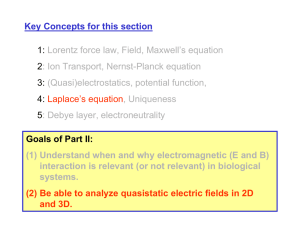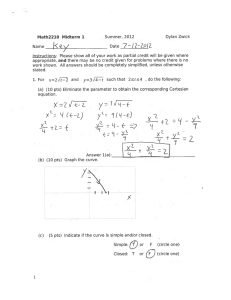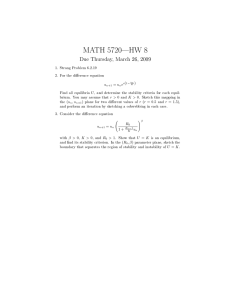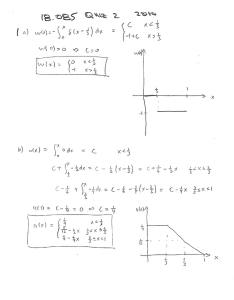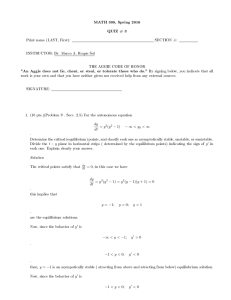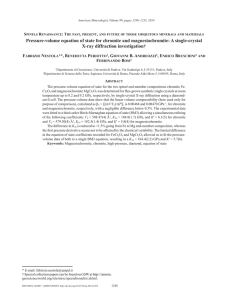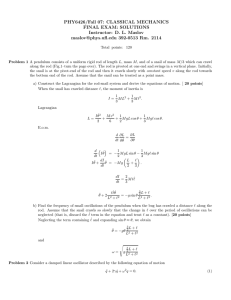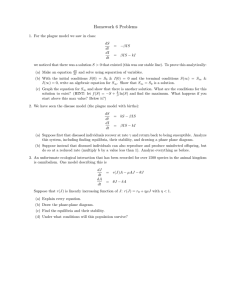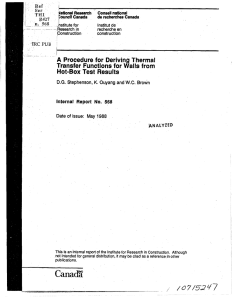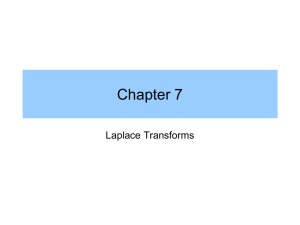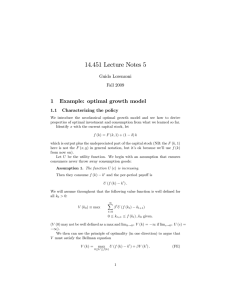1: 2 3: Lorentz force law, Field, Maxwell’s equation
advertisement
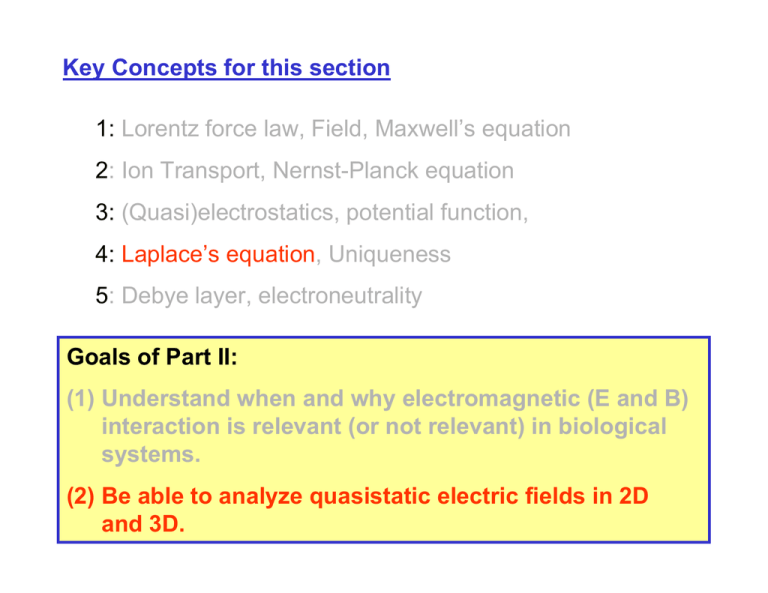
Key Concepts for this section 1: Lorentz force law, Field, Maxwell’s equation 2: Ion Transport, Nernst-Planck equation 3: (Quasi)electrostatics, potential function, 4: Laplace’s equation, Uniqueness 5: Debye layer, electroneutrality Goals of Part II: (1) Understand when and why electromagnetic (E and B) interaction is relevant (or not relevant) in biological systems. (2) Be able to analyze quasistatic electric fields in 2D and 3D. r E = −∇Φ ∇2Φ = − ρe ε r ∇ ⋅ (ε E ) = ∇ ⋅ (−ε∇Φ ) = ρe ( Poisson ' s Equation) However, biomolecules in the system do not generate E-field, since they are shielded by counterions (electroneutrality)……. It all comes down to solving….. ∂c ∇ c= (Fick’s second law) ∂t 2 ∇ 2 Φ = 0 ( Laplace ' s Equation) ∇ 2c = 0 r q = −k ∇T (Fourier’s law for heat conduction) r ∇ ⋅ q = 0 (conservation law for heat) (steady-state diffusion) ∇ 2T = 0 (steady heat flow) Electrostatics Steady state diffusion ∇ 2 c = 0 Φ2=0 Φ1=0 Φ=? Φ5=0 c2=0 c1=0 c=0 Φ3=0 c5=0 c4=0 Φ4=0 Thermal conduction T2=0 T1=0 ∇ 2T = 0 T=0 T5=0 T4=0 T3=0 c3=0 Uniqueness of Solution Let’s assume two different solutions, Φa and Φb ρe ; Φ a = Φ i on Si ε ρ ∇ 2 ⋅ Φ b = − e ; Φ b = Φ i on Si ε ∇2 ⋅ Φa = − Then define Φ d = Φ a − Φ b ∇ 2 ⋅ Φ d = 0; Φ d = 0 on Si S2 S1 Answer: Φd = 0 (satisfy Laplace Eq.) for everywhere ∴ Φ a − Φb = 0 ∇2 ⋅ Φ d = 0 S5 Φ d = 0 on all S4 Si S3 Gel Electrophoresis Plastic (σ =0) Pt electrode Gel (ε, σ) Φ=V0 biomolecules r r ∂B ∇× E = − = 0 (electrostatics) ∂t r E = −∇Φ ur ∂ρ ∇⋅ J = − = 0 (steady state, no charge accumulation) ∂t ur ur r 2 ∇ Φ=0 ∇⋅ J = ∇⋅ σ E = 0 ∇⋅E = 0 ( ) y W ∂Φ ∂y =0 y =W Φ=0 when x=0 Φ=V0 when x=L ∂Φ ∂y ur ∇⋅ J = 0 ur J = J x xˆ J=0 (insulator) =0 L x y =0 (no charge accumulation) J y = σ Ey = 0 = ∂Φ ∂y y = 0 or W Boundary Conditions (For EQS approximation) ur ρ ∇⋅E = ε r ∇× E = 0 ur ∂ρ ∇⋅ J = − ∂t uur uur nˆ ⋅ (ε1 E1 − ε 2 E2 ) = σ s uur uur r nˆ × E1 = nˆ × E2 ( E1 tangential r = E2 tangential ) uur uur ∂σ nˆ ⋅ (σ 1 E1 − σ 2 E2 ) = − s ∂t Figure 5.3.1 (a) Differential contour intersecting surface supporting surface charge density. (b) Differential volume enclosing surface charge on surface having normal n. Courtesy of Herman Haus and James Melcher. Used with permission. Source: http://web.mit.edu/6.013_book/www/ Electrostatics Steady Diffusion Φ=V0 Φ=0 Gel or tissue (σ,ε) Φ=0 2 ∇ Φ=0 r J e = −σ∇Φ C=C0 Φ=0 C=0 Gel or tissue (D) C=0 ∇ 2C = 0 r J i = − Di ∇ci C=0 Figure 5.5.1 Two of the infinite number of potential functions having the form of (1) that will fit the boundary conditions Φ = 0 at y = 0 and at x = 0 and x = a. Courtesy of Herman Haus and James Melcher. Used with permission. Source: http://web.mit.edu/6.013_book/www/ Solution Known Solutions for Laplace equations Cylindrical Coordinates ∂ 2 Φ 1 ∂Φ 1 ∂ 2 Φ ∂ 2 Φ ∇ Φ( ρ , ϕ , z ) = 0 ⇒ + + 2 + 2 =0 2 2 ρ ∂ρ ρ ∂ϕ ∂ρ ∂z Φ ( ρ , ϕ , z ) = R( ρ )Ψ (ϕ ) Ζ( z ) R( ρ ) ⇒ Bessel Functions ( J n , N n , I n , K n ) 2 Ψ (ϕ ) ⇒ Trigonometric (sin, cos,sinh, cosh) Ζ( z ) ⇒ Trigonometric (sin, cos,sinh, cosh) Spherical Coordinates ∇ Φ(r ,θ , ϕ ) = 0 ⇒ 2 1 ∂ ⎛ 2 ∂Φ ⎞ 1 ∂ ⎛ ∂Φ ⎞ 1 ∂ 2Φ =0 ⎜r ⎟+ 2 ⎜ sin θ ⎟+ 2 2 2 2 r ∂r ⎝ ∂r ⎠ r sin θ ∂θ ⎝ ∂θ ⎠ r sin θ ∂ϕ Φ (r ,θ , ϕ ) = R(r )Θ(θ )Ψ (ϕ ) R(r ) ⇒ Spherical Bessel Functions Θ(θ ) ⇒ Legendre Functions ( Pn (cos θ )) Ψ (ϕ ) ⇒ Trigonometric (sin ϕ , cos ϕ ) Solving Laplace’s Equation (Numerically) 2 d Φ = 0 → Φ ( x) = ax + b 1D case: 2 dx Φ (n − 1, m) 2 2 ∂ Φ ∂ Φ 2D case: + =0 2 2 ∂x ∂y ∂Φ 1 (n + , m) = Φ (n + 1, m) − Φ (n, m) ∂x 2 Φ (n, m + 1) Φ ( n, m ) Φ (n + 1, m) Φ (n, m − 1) y (m) x (n) ∂Φ 1 (n − , m) = Φ (n, m) − Φ (n − 1, m) ∂x 2 1 1 ∂ 2Φ ∂Φ ∂Φ ( n , m ) ( n , m ) ( n , m) = Φ (n + 1, m) + Φ (n − 1, m) − 2Φ (n, m) = + − − 2 2 2 ∂x ∂x ∂x Φ (n, m + 1) Laplace’s equation In discretized form Φ (n − 1, m) Φ ( n, m ) Φ (n + 1, m) Φ (n, m − 1) y (m) ∂ 2Φ ∂ 2Φ ( n, m ) + 2 ( n , m ) = 2 ∂x ∂y Φ (n + 1, m) + Φ (n − 1, m) + Φ (n, m + 1) + Φ (n, m − 1) − 4Φ (n, m) = 0 x (n) Φ (n + 1, m) + Φ (n − 1, m) + Φ (n, m + 1) + Φ (n, m − 1) Φ ( n, m ) = 4 Value in the middle = average of surrounding values Finite Element Method
